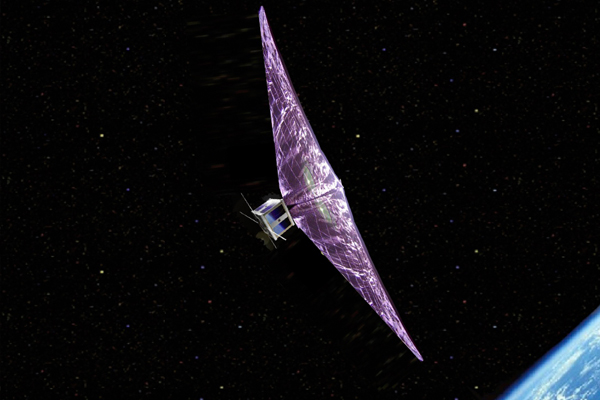Purdue wins a launch slot on Atlas V
Purdue wins a launch slot on Atlas V
| Author: | Marti LaChance |
|---|---|
| Magazine Section: | Breaking News |
| Article Type: | Feature |
In September, Purdue researchers working on the Aerodynamic Deorbit Experiment (ADE) won the opportunity from United Launch Alliance to send their experiment on a future Atlas V rocket mission.

Purdue's was one of four proposals selected by the launch service provider to receive a free CubeSat launch slot. The company's innovative new rideshare program, dubbed CubeCorp, encourages hands-on experience to motivate, educate and develop the next generation of rocket scientists and space entrepreneurs. The ADE project will involve students throughout the flight project life cycle, including design, integration, testing and mission operations.
"ADE represents the first Purdue-developed satellite that will be launched and operated in orbit," says David Spencer, associate professor of aeronautics and astronautics and principal investigator on the project. "Launching a fully functional satellite is a big step forward for our astronautics research and educational opportunities."

Purdue's ADE is a small-scale prototype of a bolt-on device that can be used to deorbit 150 kg-class satellites from orbit altitudes of up to 1,200 km in less than 25 years. Twenty-five years is an international standard for the deorbit of satellites following their useful mission, in order to reduce the amount of debris in orbit. Without the deployable drag device, a 150 kg-class satellite with an initial orbit altitude of 1,200 km could take more than 100 years to deorbit naturally.
The specific objectives of the ADE mission are to provide flight qualification and characterize the performance of the first-ever passive, aerodynamically stable, deployable drag device to accelerate the deorbit of CubeSats and small satellites.
The ADE 1U CubeSat (10 cm x 10 cm x 10 cm) will deploy a thin-membrane dragsail with 1m-long booms. The geometry of the drag device is designed to be aerodynamically stable and passively trim to a maximum-drag attitude. "The capability of this system to align itself into a maximum drag orientation as it passes through the atmosphere will allow satellites to deorbit more rapidly after the end of their useful missions," Spencer says.
ADE will be deployed from the launch vehicle into a geosynchronous transfer orbit with orbit altitudes ranging from 185 km to 35,756 km. Based on simulations, once the dragsail is deployed, the system should deorbit in about 11 days. ADE will collect acceleration and angular rate data during each pass through the upper reaches of the Earth's atmosphere. The team will use the acquired data set to assess the aerodynamic stability of the system.

"Companies and organizations like SpaceX and OneWeb are actively pursuing the deployment of thousands of small satellites into this regime for global internet service," Spencer says. "A successful ADE mission will demonstrate the viability of the drag device, with commercial application relevant to the deorbit of large constellations of satellites." Spencer says the research group is targeting a launch date in the second quarter of 2018.
"ULA is passionate about educating and developing future leaders in the space industry," says Tory Bruno, ULA CEO and president. "We've established a very low-cost approach to CubeSat design and launch to accommodate our commitment to STEM and innovative commercial CubeSat entrepreneurs."
Alina Alexeenko, professor of aeronautics and astronautics at Purdue, is co-PI on the project. Alexandra Long, a PhD candidate from Georgia Tech, is the cognizant engineer for the drag device. Garry Qualls at NASA Langley Research Center (LaRC) has generously offered the use of the LarkWorks MakerSpace facility for prototyping the deployment mechanisms and mechatronic systems. Les Johnson at NASA Marshall Space Flight Center is serving as an advisor to the project. Johnson is currently the PI for the Near Earth Asteroid Scout solar sail.